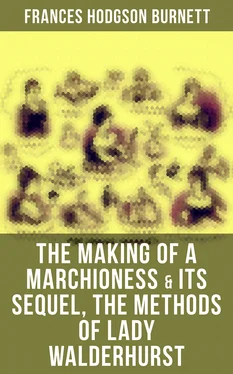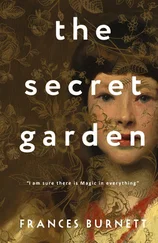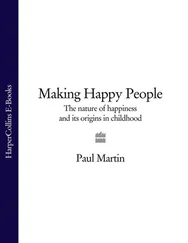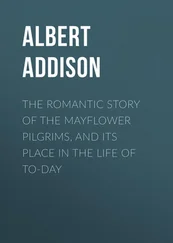The Como rug played a large part in the decoration of the apartment. One of them, with a piece of tape run through a hem, hung over the door in the character of a _portière_; another covered a corner which was Miss Fox-Seton’s sole wardrobe. As she began to get work, the cheerful, aspiring creature bought herself a Kensington carpet-square, as red as Kensington art would permit it to be. She covered her chairs with Turkey-red cotton, frilling them round the seats. Over her cheap white muslin curtains (eight and eleven a pair at Robson’s) she hung Turkey-red draperies. She bought a cheap cushion at one of Liberty’s sales, and some bits of twopenny-halfpenny art china for her narrow mantelpiece. A lacquered tea-tray and a tea-set of a single cup and saucer, a plate and a teapot, made her feel herself almost sumptuous. After a day spent in trudging about in the wet or cold of the streets, doing other people’s shopping, or searching for dressmakers or servants’ characters for her patrons, she used to think of her bed-sitting-room with joyful anticipation. Mrs. Cupp always had a bright fire glowing in her tiny grate when she came in, and when her lamp was lighted under its home-made shade of crimson Japanese paper, its cheerful air, combining itself with the singing of her little, fat, black kettle on the hob, seemed absolute luxury to a tired, damp woman.
Mrs. Cupp and Jane Cupp were very kind and attentive to her. No one who lived in the same house with her could have helped liking her. She gave so little trouble, and was so expansively pleased by any attention, that the Cupps,—who were sometimes rather bullied and snubbed by the “professionals” who generally occupied their other rooms,—quite loved her. Sometimes the “professionals,” extremely smart ladies and gentlemen who did turns at the balls or played small parts at theatres, were irregular in their payments or went away leaving bills behind them; but Miss Fox-Seton’s payments were as regular as Saturday night, and, in fact, there had been times when, luck being against her, Emily had gone extremely hungry during a whole week rather than buy her lunches at the ladies’ tea-shops with the money that would pay her rent. In the honest minds of the Cupps, she had become a sort of possession of which they were proud. She seemed to bring into their dingy lodging-house a touch of the great world,—that world whose people lived in Mayfair and had country-houses where they entertained parties for the shooting and the hunting, and in which also existed the maids and matrons who on cold spring mornings sat, amid billows of satin and tulle and lace, surrounded with nodding plumes, waiting, shivering, for hours in their carriages that they might at last enter Buckingham Palace and be admitted to the Drawing-room. Mrs. Cupp knew that Miss Fox-Seton was “well connected;” she knew that she possessed an aunt with a title, though her ladyship never took the slightest notice of her niece. Jane Cupp took “Modern Society,” and now and then had the pleasure of reading aloud to her young man little incidents concerning some castle or manor in which Miss Fox-Seton’s aunt, Lady Malfry, was staying with earls and special favorites of the Prince’s. Jane also knew that Miss Fox-Seton occasionally sent letters addressed “To the Right Honourable the Countess of So-and-so,” and received replies stamped with coronets. Once even a letter had arrived adorned with strawberry-leaves, an incident which Mrs. Cupp and Jane had discussed with deep interest over their hot buttered-toast and tea.
Emily Fox-Seton, however, was far from making any professions of grandeur. As time went on she had become fond enough of the Cupps to be quite frank with them about her connections with these grand people. The countess had heard from a friend that Miss Fox-Seton had once found her an excellent governess, and she had commissioned her to find for her a reliable young ladies’ serving-maid. She had done some secretarial work for a charity of which the duchess was patroness. In fact, these people knew her only as a well-bred woman who for a modest remuneration would make herself extremely useful in numberless practical ways. She knew much more of them than they knew of her, and, in her affectionate admiration for those who treated her with human kindness, sometimes spoke to Mrs. Cupp or Jane of their beauty or charity with a very nice, ingenuous feeling. Naturally some of her patrons grew fond of her, and as she was a fine, handsome young woman with a perfectly correct bearing, they gave her little pleasures, inviting her to tea or luncheon, or taking her to the theatre.
Her enjoyment of these things was so frank and grateful that the Cupps counted them among their own joys. Jane Cupp—who knew something of dressmaking—felt it a brilliant thing to be called upon to renovate an old dress or help in the making of a new one for some festivity. The Cupps thought their tall, well-built lodger something of a beauty, and when they had helped her to dress for the evening, baring her fine, big white neck and arms, and adorning her thick braids of hair with some sparkling, trembling ornaments, after putting her in her four-wheeled cab, they used to go back to their kitchen and talk about her, and wonder that some gentleman who wanted a handsome, stylish woman at the head of his table, did not lay himself and his fortune at her feet.
“In the photograph-shops in Regent Street you see many a lady in a coronet that hasn’t half the good looks she has,” Mrs. Cupp remarked frequently. “She’s got a nice complexion and a fine head of hair, and—if you ask me —she’s got as nice a pair of clear eyes as a lady could have. Then look at her figure—her neck and her waist! That kind of big long throat of hers would set off rows of pearls or diamonds beautiful! She’s a lady born, too, for all her simple, everyday way; and she’s a sweet creature, if ever there was one. For kind-heartedness and goodnature I never saw her equal.”
Miss Fox-Seton had middle-class patrons as well as noble ones,—in fact, those of the middle class were far more numerous than the duchesses,—so it had been possible for her to do more than one good turn for the Cupp household. She had got sewing in Maida Vale and Bloomsbury for Jane Cupp many a time, and Mrs. Cupp’s dining-room floor had been occupied for years by a young man Emily had been able to recommend. Her own appreciation of good turns made her eager to do them for others. She never let slip a chance to help any one in any way.
It was a goodnatured thing done by one of her patrons who liked her, which made her so radiant as she walked through the mud this morning. She was inordinately fond of the country, and having had what she called “a bad winter,” she had not seen the remotest chance of getting out of town at all during the summer months. The weather was beginning to be unusually hot, and her small red room, which seemed so cosy in winter, was shut in by a high wall from all chance of breezes. Occasionally she lay and panted a little in her cot, and felt that when all the private omnibuses, loaded with trunks and servants, had rattled away and deposited their burdens at the various stations, life in town would be rather lonely. Every one she knew would have gone somewhere, and Mortimer Street in August was a melancholy thing.
And Lady Maria had actually invited her to Mallowe. What a piece of good fortune-what an extraordinary piece of kindness!
She did not know what a source of entertainment she was to Lady Maria, and how the shrewd, worldly old thing liked her. Lady Maria Bayne was the cleverest, sharpest-tongued, smartest old woman in London. She knew everybody and had done everything in her youth, a good many things not considered highly proper. A certain royal duke had been much pleased with her and people had said some very nasty things about it. But this had not hurt Lady Maria. She knew how to say nasty things herself, and as she said them wittily they were usually listened to and repeated.
Читать дальше












